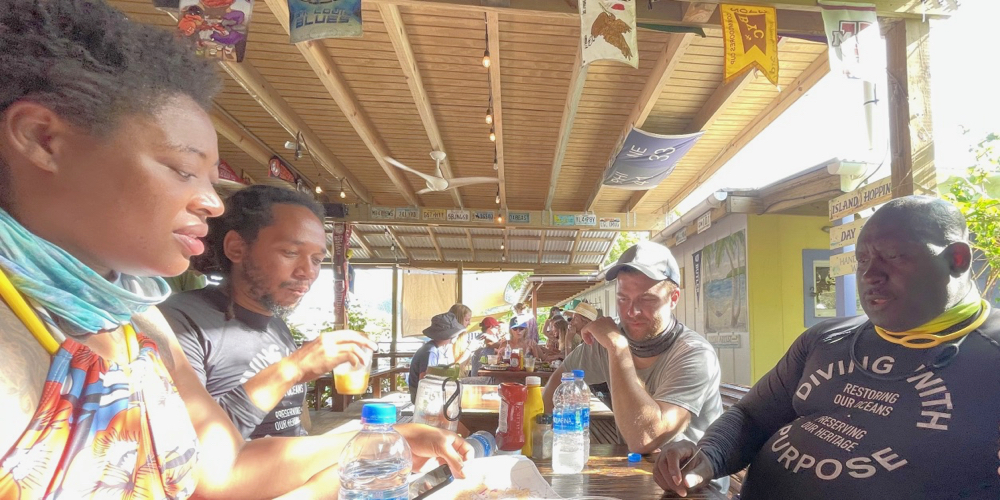
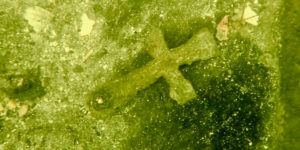
In mid-July, a team of divers from several organizations took to the murky waters of Coral Bay harbor to confirm what several local divers have quietly alleged for a long time: the existence of a partially buried ship dating back to the early 1700s that could prove to have great historical significance.
Jay Haigler, a board member and lead instructor for Diving with a Purpose, was part of a 10-member team that included members of his organization, the National Association of Black Scuba Divers, the Society of Black Archaeologists and Search Inc.
The purpose of the expedition was to assist in defining the age of the wreck, assessing its size, and documenting the part of the ship that is currently exposed. Nearly 30 feet of the ship is above the muddy bottom, “But we believe there is more covered with sand and silt,” Haigler said. “Further testing and evaluation is warranted.”
Experienced in maritime archaeology, Haigler is cautious about drawing conclusions about what the team discovered in its nine days of diving in Coral Bay. Researchers are still processing the data collected from this preliminary expedition, he said, “and there’s a lot more data we need to collect before we can make an interpretation.”
However, given the date of the wreck, Haigler was willing to speculate that “It might be possible, and I have to stress the word ‘might,’ that this ship was associated with the Slave Insurrection of 1733. That would be historically significant.”
Haigler said he was contacted in April by David M. Brewer, the senior archaeologist with the State Historic Preservation Office, a division of the V.I. Department of Planning and Natural Resources, who was seeking to know more about the wreck and its location.
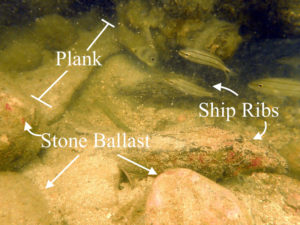
In 2013, the ballast of the wreck had been noted – but not deemed significant – during a marine survey required by Coastal Zone Management as part of the permitting process for the Summer’s End Group’s St. John Marina. (That organization, which first presented its plans to build a 144-slip mega-marina in Coral Bay in 2014, now has its permit from Coastal Zone Management but awaits its permit from the U.S. Army Corps of Engineers.)
After local divers brought further details to the attention of the Historic Preservation Office, the area was re-surveyed in 2016. Now, Brewer said, the expedition in July confirmed the existence of the wreck and determined that it was not within the marina’s footprint.
“Now the Army Corps of Engineers is involved with the attendant surveys, and we’re operating under them,” Brewer said.
Before the expedition in July, officials were uncertain about the historic nature of the shipwreck, but local divers who knew about the wreck quietly contended that it was several centuries old and culturally significant. They kept the discovery a secret in order to protect the site.
“The wreck was first found by people more than 30 years ago,” said Colin Hanson, a long-time Coral Bay resident. Hanson and his wife Leah Randall, the owners of FlyAway Charters, are avid historians and offer a specialized historical and snorkeling tour to charter guests aboard their boats.
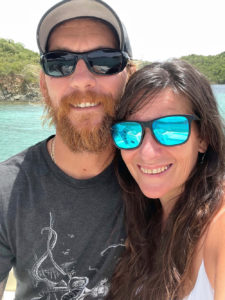
Hanson had seen the ballast of the ship while retrieving a solar panel that had fallen off a boat, but he didn’t start diving the wreck until several years ago when Dickey Connors, who installs and maintains moorings, told Hanson and Randall about finding the ship’s timbers and other artifacts.
“We dived it and found clay pipes and bottles,” said Hanson. Over the course of years, wave action displaced silt and revealed more artifacts, including trunnels (wooden fasteners), suspected musket barrels, a cross, and an anchor.
Hanson contacted Ken Wild, the Virgin Islands National Park’s archaeologist, who volunteered to help survey and map the wreck. Wild confirmed that the pipe was distinctly Dutch in origin and the bottle was a classic example of those made in the 1730s. He agreed to write a report to submit to the Historic Preservation Office “for no other reason than the wreck was important and the office needed to know about it.”
Hanson said he was gratified that the site, now known as “Coral Bay Shipwreck No. 1,” is getting the attention it deserves.
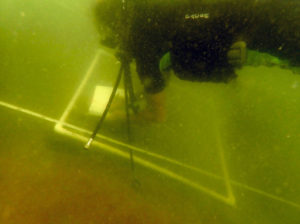
In addition to Jay Haigler and others from Diving with a Purpose, the team that explored the site in July included Justin Dunnavant and Ayana Flewellen, co-founders of the Society of Black Archaeologists; that organization’s mission, among other things, “is to promote the proper treatment of African and African diaspora material culture.”
Several team members have spent time on St. Croix as part of the Slave Wrecks Project.
The team also included Kyle Lent of Search, Inc., the country’s largest cultural resource management firm, which since 1993 has been involved with 3,700 projects in 44 states and 37 countries. It includes SearchH2O, the largest maritime archaeology program in the United States.
Coral Bay Shipwreck No. 1 is being documented by renowned underwater photographers Jennifer Hayes and David Doubilet.
The dive team also received assistance from Busy Bee Charters and Amy Dempsey of Bioimpact Inc.
The team deployed sonar technology to generate images as well as a magnetometer, a device that identifies objects made of metal by picking up anomalies in electromagnetic waves sent from the surface to the bottom and back again. Haigler said the team found iron fasteners and copper sheathing near the wreck and identified spots for further exploration.
Haigler hopes that in the future divers find something definitive to identify the wreck, like a ship’s bell with the name of the ship inscribed. In the absence of such a discovery, researchers will have to do a deep dive into archival records to find out what ships might have been in Coral Bay around the time.
Although it’s too early to tell what the purpose of the ship was, Brewer from DPNR confirmed that the ship dates back to the early 1700s.
“How do we know that? A bottle was found on the wreck,” he said. “In the old days, bottles changed shape about every ten years or so as they got better at making them. It fits the time period of the Slave Insurrection.”
“The conditions [for diving the wreck] were horrible,” Brewer continued. “It was very silty. At times divers could see only a few inches, but they gathered enough data. There’s no doubt we’ll have to go back. At some point, we’ll have to suck the mud off to see the rest of it and collect diagnostic artifacts that tighten the wreck’s date, nationality, and function.”
The actual work of the excavation is challenging, and those who follow the project and expect to see a fully intact ship loaded with artifacts and possibly treasure will no doubt be disappointed. The ship’s outline is difficult to see and many of the artifacts are fused with coral. Given the ship’s condition, raising the ship to preserve it on land is unlikely, Brewer said.
However, that does not negate the value of the discovery. The excavation team is more interested in promoting “an island-wide effort to support our submerged cultural heritage,” Haigler said. “It’s important that we tell these stories.”
Colin Hanson wants to see the harbor of Coral Bay surveyed to find out what other historic wrecks might be discovered.
“We could have multiple shipwrecks in a harbor that’s been used for hundreds of years. Diving with a Purpose got hundreds of ‘hits’ with the magnetometer when the team was here. Those deserve further study,” he said.
He worries that the history will be lost if the construction of a marina begins before such a survey can be completed.
“Members of the community are crying out for information about the past,” said Leah Randall. “We have to take care of these things before we ‘pave it over.’ Although the marina plans have been re-drawn to no longer encompass the exact footprint of the wreck, the process of constructing a marina will destroy the opportunity before us now.”
Randall said that FlyAway Charters’ “St. John: Uncovered” history tour has been gaining in popularity, and “the vast majority of our guests that don’t sign up for it still enjoy the historical information we include in our regular charters; they often ask for more.”
She would like to see the old schoolhouse on the East End of St. John be converted into a cultural history museum. The Coral Bay Community Council has been working to secure a grant and assure the structure’s preservation on the National Register of Historic Places. It was last used as a retreat by members of Gov. Alexander Farrelly’s administration in the 1980s. Randall thinks it’s the ideal spot to showcase artifacts from Coral Bay Shipwreck No. 1 and the wreck of the Santa Monica, which was grounded in nearby Round Bay in 1782.
In fact, the East End of St. John has a particularly rich maritime history. Of the 959 residents of St. John in 1917, 44 – most of whom lived in Coral Bay or the East End – listed their occupations as seaman; 30 other island residents identified their occupations as fisherman, and others worked as carpenters at the East End shipyard, according to an article written by Crystal Fortwangler in the St. John Historical Society’s publication “St. John – Life in Five Quarters.”
Violet Sewer Mahabir, best known as the owner of Vie’s Snack Shack on the East End of St. John from 1979 to 2016, said her family’s seafaring tradition goes back to the 1700s.
“We always had boats,” she said. Her great-grandfather Moshe Sewer was well-known for being the captain of the Roma, a trading schooner that made voyages to Trinidad and the United States until it was destroyed in a hurricane in the 1930s.
Much of this history is being forgotten, especially now as St. John is gaining popularity as a place to party rather than a quiet destination for those who appreciate natural and cultural history.
“I think the USVI just needs to start offering more historical experiential tourism options to our guests,” Randall said. “It seems to us many of them genuinely love and appreciate the history and would love to respectfully learn more.”





